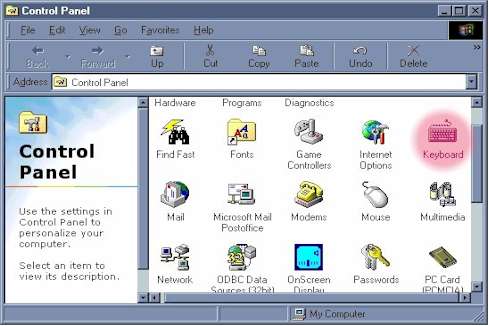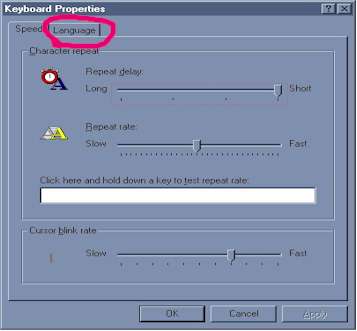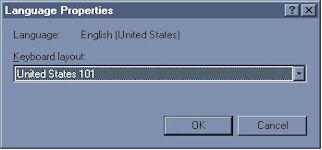 An American Keyboard
An American Keyboard with a European Flair!
 An American Keyboard
An American Keyboard
with a European Flair!
IMPORTANT: This solution turns your apostrophe, quotation marks, tilde, and circumflex keys into dead keys for accents. When you hit one of these keys, nothing happens until you hit the next key, which must be either the letter you want to mark, or the space bar, which gives you the mark from the original US keyboard. The right Alternate key also becomes an optional character key, allowing quick typing of several foreign letters and symbols. Once installed, you'll need to play around and practice a little to get used to this.
Here's what you do in Windows 95 through 2000 (click here for Windows XP):
1) Go to the START button (lower left of your screen)
2) Open SETTINGS and CONTROL PANEL, to get a screen like this:

3) Double click on the KEYBOARD icon to get the window below:

4) Click on the LANGUAGE tab, circled above.
Your keyboard is probably set for the US 101 configuration, as below.

5) Click the down arrow and select the US-International configuration below:
![]()
6) Click OK until you're back to the Control Panel and close it.
 Now you can open Notepad, your word processor, or your email
client and begin typing in French, Spanish, German, Portuguese, etc. For
an acute accent (é), begin by typing ' and any vowel. For a "c
cedilla" (ç), type ' and the letter c. For a tilde (ñ, ã), type ~
and n or any vowel. The right alternate key (or character key) also gives
you easy access to many characters.
Now you can open Notepad, your word processor, or your email
client and begin typing in French, Spanish, German, Portuguese, etc. For
an acute accent (é), begin by typing ' and any vowel. For a "c
cedilla" (ç), type ' and the letter c. For a tilde (ñ, ã), type ~
and n or any vowel. The right alternate key (or character key) also gives
you easy access to many characters.
This link will give you a nice summary of the US International keyboard.
Follow this link if you want to switch back and forth between a standard US and an international keyboard.
A special email note: Email poses a few special problems, most deriving from the way some American servers process characters. If your email is set to HTML or RTF (Rich Test Format), the accents should work correctly, though some recipients may get garbled code. If you use a plain text format, try the MIME setting with QUOTED PRINTABLE encoding. These choices should be listed somewhere in the options settings of your email program.
OR
Vous êtes le visiteur numéro
aux pages de Michael Lastinger.